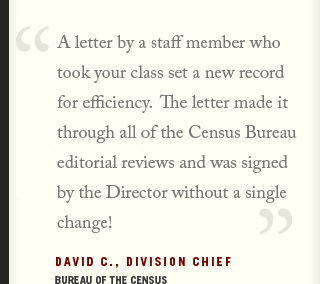Technical Writing Seminars Prompt Overhaul of Key Client Documents
Colorado Springs, CO — December 17, 2007 — After technical writing seminars by the Murawski Group (TMG), a major defense contractor is revamping its supplier contracts and more to use “you” for the reader.
Although instructions to the paying public, such as software licenses and computer manuals, have come around to the “you” approach, much technical and legal writing still avoids natural references to people. So when a seminar persuades a client to adopt the “you” approach in standard instructions, it’s news.
The benefits are explained in the guide that accompanies TMG’s technical writing seminars: “For writers, ‘you’ reduces passive voice and straightens out sentences, revealing other opportunities for improvement. For readers, ‘you’ provides a steady place amid the complexity. The resulting clarity improves compliance and enforcement.”
In the defense contractor’s standards of conduct, “you” transforms a static 16-page essay into a call for action (the direct sentence implies “you,” defined earlier as any employee):
Roundabout: Sufficient care must be taken to ensure proper recording and charging of all costs to the appropriate account, regardless of the status of the budget for that account. (28 words before technical writing seminar)
Direct: Charge costs to the right account, whatever the status of its budget. (12 words after technical writing seminar)
TMG’s technical writing seminars have helped government and industry apply the “you” approach to many hundreds of instructions that carry such names as regulations, manuals, directives, orders, plans, compliance guides, ISO procedures, and statements of work. Some have earned White House awards.
For the fine points of “you” and other essentials of effective instructions, see Writing Readable Regulations.
Founded in 1985, the Murawski Group, Inc. is a boutique training and consulting company with a specialty in customized technical writing speaking seminars. Clients include Fortune 500 companies, all 15 federal cabinet departments, and the White House.


